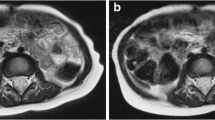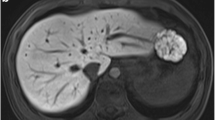Abstract
Objective
To compare the image quality of contrast-enhanced abdominopelvic 3D fat-suppressed T1-weighted gradient-echo imaging with radial and conventional Cartesian k-space acquisition schemes in paediatric patients.
Methods
Seventy-three consecutive paediatric patients were imaged at 1.5 T with sequential contrast-enhanced T1-weighted Cartesian (VIBE) and radial gradient echo (GRE) acquisition schemes with matching parameters when possible. Cartesian VIBE was acquired as a breath-hold or as free breathing in patients who could not suspend respiration, followed by free-breathing radial GRE in all patients. Two paediatric radiologists blinded to the acquisition schemes evaluated multiple parameters of image quality on a five-point scale, with higher score indicating a more optimal examination. Lesion presence or absence, conspicuity and edge sharpness were also evaluated. Mixed-model analysis of variance was performed to compare radial GRE and Cartesian VIBE.
Results
Radial GRE had significantly (all P < 0.001) higher scores for overall image quality, hepatic edge sharpness, hepatic vessel clarity and respiratory motion robustness than Cartesian VIBE. More lesions were detected on radial GRE by both readers than on Cartesian VIBE, with significantly higher scores for lesion conspicuity and edge sharpness (all P < 0.001).
Conclusion
Radial GRE has better image quality and lesion conspicuity than conventional Cartesian VIBE in paediatric patients undergoing contrast-enhanced abdominopelvic MRI.
Key Points
• Numerous techniques are required to provide optimal MR images in paediatric patients.
• Radial free-breathing contrast-enhanced acquisition demonstrated excellent image quality.
• Image quality and lesion conspicuity were better with radial than Cartesian acquisition.
• More lesions were detected on contrast-enhanced radial than on Cartesian acquisition.
• Radial GRE can be used for performing abdominopelvic MRI in paediatric patients.





Similar content being viewed by others
References
Darge K, Anupindi SA, Jaramillo D (2011) MR imaging of the abdomen and pelvis in infants, children, and adolescents. Radiology 261:12–29
MacKenzie JD, Vasanawala SS (2010) State-of-the-art in pediatric body and musculoskeletal magnetic resonance imaging. Semin Ultrasound CT MR 31:86–99
Michael R (2008) Potential of MR-imaging in the paediatric abdomen. Eur J Radiol 68:235–244
Olsen OE (2008) Imaging of abdominal tumours: CT or MRI? Pediatr Radiol 38:S452–S458
Axel L, Summers RM, Kressel HY, Charles C (1986) Respiratory effects in two-dimensional Fourier transform MR imaging. Radiology 160:795–801
Ehman RL, McNamara MT, Brasch RC, Felmlee JP, Gray JE, Higgins CB (1986) Influence of physiologic motion on the appearance of tissue in MR images. Radiology 159:777–782
Maki JH, Chenevert TL, Prince MR (1997) The effects of incomplete breath-holding on 3D MR image quality. J Magn Reson Imaging 7:1132–1139
Schultz CL, Alfidi RJ, Nelson AD, Kopiwoda SY, Clampitt ME (1984) The effect of motion on two-dimensional Fourier transformation magnetic resonance images. Radiology 152:117–121
Dearlove O, Corcoran JP (2007) Sedation of children undergoing magnetic resonance imaging. Br J Anaesth 98:548–549
Lawson GR (2000) Controversy: sedation of children for magnetic resonance imaging. Arch Dis Child 82:150–153
Nagle SK, Busse RF, Brau AC et al (2012) High resolution navigated three-dimensional T(1)-weighted hepatobiliary MRI using gadoxetic acid optimized for 1.5 Tesla. J Magn Reson Imaging 36:890–899
Vasanawala SS, Iwadate Y, Church DG, Herfkens RJ, Brau AC (2010) Navigated abdominal T1-W MRI permits free-breathing image acquisition with less motion artifact. Pediatr Radiol 40:340–344
Young PM, Brau AC, Iwadate Y et al (2010) Respiratory navigated free breathing 3D spoiled gradient-recalled echo sequence for contrast-enhanced examination of the liver: diagnostic utility and comparison with free breathing and breath-hold conventional examinations. AJR Am J Roentgenol 195:687–691
Lin W, Guo J, Rosen MA, Song HK (2008) Respiratory motion-compensated radial dynamic contrast-enhanced (DCE)-MRI of chest and abdominal lesions. Magn Reson Med 60:1135–1146
Song HK, Dougherty L (2004) Dynamic MRI with projection reconstruction and KWIC processing for simultaneous high spatial and temporal resolution. Magn Reson Med 52:815–824
Azevedo RM, de Campos RO, Ramalho M, Heredia V, Dale BM, Semelka RC (2011) Free-breathing 3D T1-weighted gradient-echo sequence with radial data sampling in abdominal MRI: preliminary observations. AJR Am J Roentgenol 197:650–657
Chandarana H, Block TK, Rosenkrantz AB et al (2011) Free-breathing radial 3D fat-suppressed T1-weighted gradient echo sequence: a viable alternative for contrast-enhanced liver imaging in patients unable to suspend respiration. Invest Radiol 46:648–653
Deng J, Miller FH, Salem R, Omary RA, Larson AC (2006) Multishot diffusion-weighted PROPELLER magnetic resonance imaging of the abdomen. Invest Radiol 41:769–775
Deng J, Omary RA, Larson AC (2008) Multishot diffusion-weighted SPLICE PROPELLER MRI of the abdomen. Magn Reson Med 59:947–953
Hirokawa Y, Isoda H, Maetani YS, Arizono S, Shimada K, Togashi K (2008) Evaluation of motion correction effect and image quality with the periodically rotated overlapping parallel lines with enhanced reconstruction (PROPELLER) (BLADE) and parallel imaging acquisition technique in the upper abdomen. J Magn Reson Imaging 28:957–962
Hirokawa Y, Isoda H, Maetani YS, Arizono S, Shimada K, Togashi K (2008) MRI artifact reduction and quality improvement in the upper abdomen with PROPELLER and prospective acquisition correction (PACE) technique. AJR Am J Roentgenol 191:1154–1158
Bamrungchart S, Tantaway EM, Midia EC et al (2013) Free breathing three-dimensional gradient echo-sequence with radial data sampling (radial 3D-GRE) examination of the pancreas: Comparison with standard 3D-GRE volumetric interpolated breathhold examination (VIBE). J Magn Reson Imaging. doi:10.1002/jmri.24064
Lustig M, Donoho D, Pauly JM (2007) Sparse MRI: the application of compressed sensing for rapid MR imaging. Magn Reson Med 58:1182–1195
Vasanawala SS, Alley MT, Hargreaves BA, Barth RA, Pauly JM, Lustig M (2010) Improved pediatric MR imaging with compressed sensing. Radiology 256:607–616
Chandarana H, Feng L, Block TK et al (2013) Free-breathing contrast-enhanced multiphase MRI of the liver using a combination of compressed sensing, parallel imaging, and golden-angle radial sampling. Invest Radiol 48:10–16
Acknowledgments
Research support in the form of hardware and software from Siemens Healthcare.
Author information
Authors and Affiliations
Corresponding author
Rights and permissions
About this article
Cite this article
Chandarana, H., Block, K.T., Winfeld, M.J. et al. Free-breathing contrast-enhanced T1-weighted gradient-echo imaging with radial k-space sampling for paediatric abdominopelvic MRI. Eur Radiol 24, 320–326 (2014). https://doi.org/10.1007/s00330-013-3026-4
Received:
Revised:
Accepted:
Published:
Issue Date:
DOI: https://doi.org/10.1007/s00330-013-3026-4




